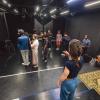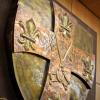Like the Sea - A Conversation with Ilona Keserü
2020
Oct
07
Ilona Keserü was born in Pécs in 1933, as a child she was taught by Ferenc Martyn, she is a prominent figure of the ‘60s generation of artists, member of the IPARTERV team and the Budapest Studio. She did theatrical set design as well; she often added textile materials to her work. Her pieces are known for their dynamic, freely moving, vivid colors. One of the central elements of her art is the Balatonudvar cemetery’s heart shaped gravestone motif. She was a teacher at the University of Pécs from 1983 and she is one of the founding members of the Pécs Conservatory of Fine Arts.
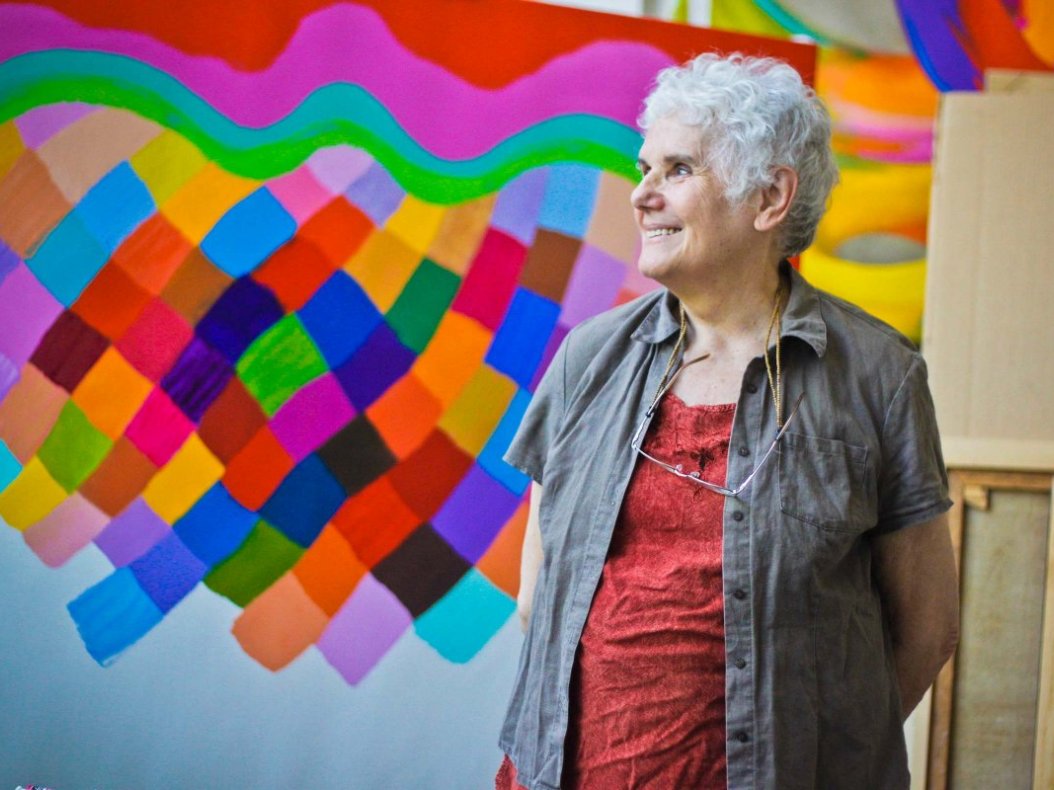
She could not travel to New York at the end of 2018 to the Metropolitan Museum of Art (MET), where they showcased her work Wall-Hanging with Tombstone Forms (Tapestry) as part of the Epic Abstraction: Pollock to Herrera exhibition, but in 2021 she hopes to be able to visit the Pompidou Center in Paris, where two of her pictures will be exhibited as part of a collective exhibition.
How did you feel about the MET exhibition, where your works were shown alongside Jackson Pollock’s, Louise Nevelson’s and Mark Rothko’s art?
Art is the greatest thing ever to exist. Back in 1970, in my apartment on Belgrád rakpart, on the bank of the Danube, I pinned one of Kenneth Noland’s pictures onto the side of my radio. I often say that artworks know about each other. At the Metropolitan, I got a chance to be a part of an exhibition together with colleagues whose career I have been following for a long time. Louise Nevelson’s giant black construct stood in the middle of the exhibit and one of Kenneth Noland’s pictures got placed next to my tapestry. The artwork he brought to the exhibit was made in a completely different period but its presence was rather friendly. Artworks know about each other. His picture was part of my room for at least 20 years.
The monetary value of the art pieces does not matter in this dimension. What I care about, is being part of the world context.
Making this happen was a piece of cake. Only they did not know that on the other side of the iron curtain. It is funny, how the art created on other continents in different economies forced the circumstances to change in a way that would allow them to step into the light. Paintings exist in a different force field. It does not matter, whether they are in a museum, a storehouse or on the wall of a house, there are certain powers connecting them.
During the creation process, their artist’s brain functions are expanded.
This is practically speaking a divine act. It happens above the world.
That painting, if the artist is good and the painting is good, will contain references to the existence of other divine acts or the just the notion that they are there… Now we know a bit more about how many kinds of intelligences there could be and we also know that we can store incredible amounts of information within our technological devices. We can only guess how large the storage capacity of our brain is. And we also suspect that we are not using all of our brain capacity. And paintings are not only made with the brain. Art is the total expression. It is up to the people how much they can acquire from the readily available opportunities. And how well they can tend to them, keeping them intact and making them their own. In a way that allows it to be able to refer to everything.
Rome has always played an important role in your life. In the past couple of years, London seems to have become important as well.
I am in contact with a gallery in London: the Stephen Friedman Gallery. I have visited multiple times. The most important events in my life happened in Rome, besides Hungary. I spent a year there in the early ‘60s. I derive several things from there. In 1962-63, you could already visit the exhibits of famous British and American artists or the celebrated Italian artist of the time there. I first got to go to London in the winter of 1971 and I spent a month there. I went to Paris for a month after that. Later on, I returned to London many times. Every time an important exhibition opened, I flew there as soon as I could settle things at home. I spent two or three days at a time there and I took notes. This concludes my curriculum vitae.
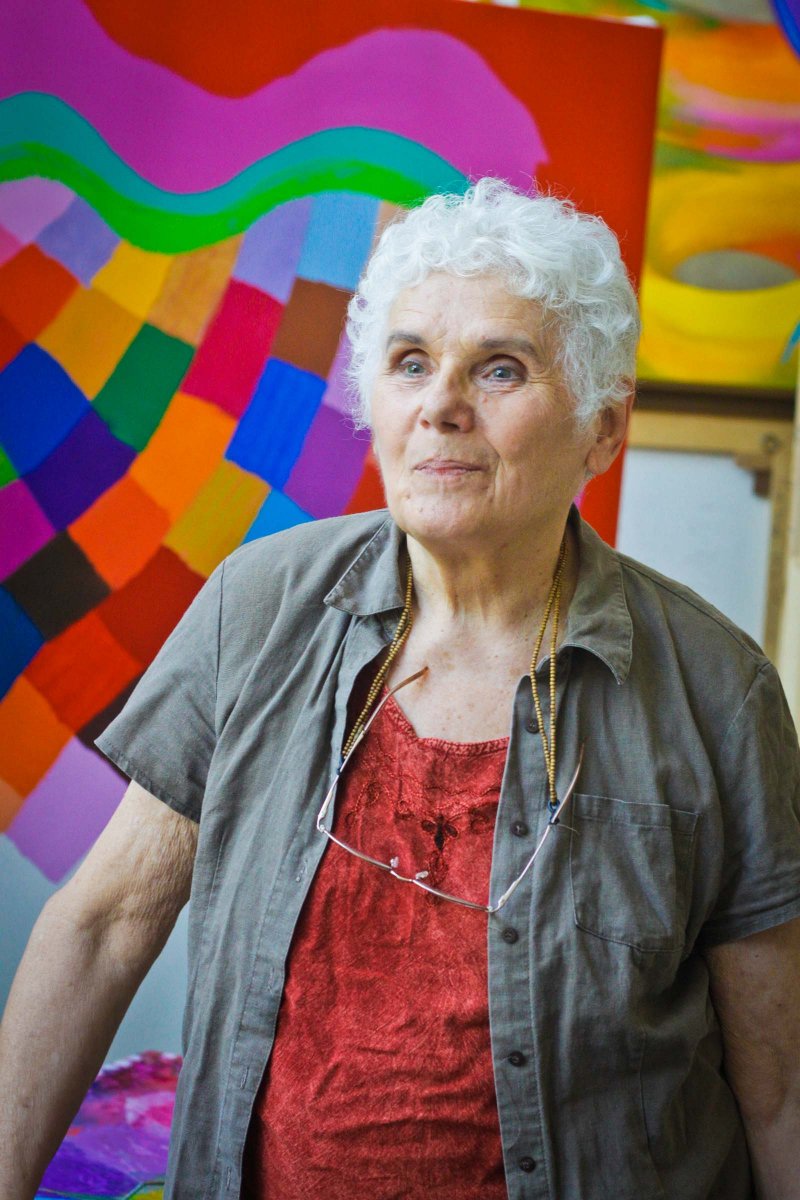
Which exhibitions have influenced your career the most?
In the winter of 1970, I got invited to the Künstler International exhibition in Cologne. Those works, which are now unable to take their well-deserved place on the international stage – the first large scale canvas embossed paintings – were there at the exhibition in Cologne. People thought they were too expensive and they did not want to buy them at that time. Now one of the paintings, which remained in my possession, is showcased at the gallery in London alongside other pieces of the ‘70s. The moment has finally arrived, when great European museums – and even those overseas – decided that they want to complete their collections of art history with what they previously did not know about, or could not deal with then.
What did you bring to London in 1970?
I carried a couple of kilos worth of catalogues and photos in my hand about my artworks and those of my friends - or should I call them brothers in arms? I had some time between visiting museums and exhibitions, so I had the idea to pay a visit to many galleries, hoping that they would care about someone waltzing in from the street; maybe they would find it interesting to know that I came from the other side of the world. This caused various scenes, sometime with yelling. They took the time to speak with me at some places, and at others, they did not.
Jasa Reinhardt told me that the pictures were intriguing; however, there are German artists, who if needed, can bring her 25 pictures by next week. While if we were to ask you, we would have no idea when or if we would get the paintings at all. I started yelling at her – I was wrong to do so – because I told her there is no way that she could get anything like this in Germany! I knew, because I just arrived from Cologne.
I could see what we could provide was missing there.
They frowned at me because raising your voice was against their norms. I remember this memory fondly. They believed it falsely that people would accept being second-class citizens of the art world. We did not accept it. A lot of people emigrated. I always came back and created my paintings here. Those pictures – the ones I was talking about – are now in possession of museums and they are not commercially available. They cannot take the same route that some less important or half-forgotten and now resurfaced pieces have.
What is a forgotten painting?
I worked a lot during the past 60 years. There were some pieces that got buried. They either got wrapped up or were put deeper back in storage. They did not stay in sight.
We did not know which works would become more important.
I find it interesting, how the evaluation of different paintings happens. Assessing how concentrated or largescale they are. This is how it could happen that the aforementioned tapestry could get into a New York exhibition thanks to the collaboration of three Hungarian art galleries; which is natural today, but fifty years ago, it would have been unimaginable. Today, many things work differently, than generations ago.
How important is an atelier? I have seen artists work in dark chambers just the same as they would in open, sunny places.
These are sentimental things. There are unbearable sights. I cannot work with that. There is self-torture enough within me, there is no need for it to come from my surroundings as well.
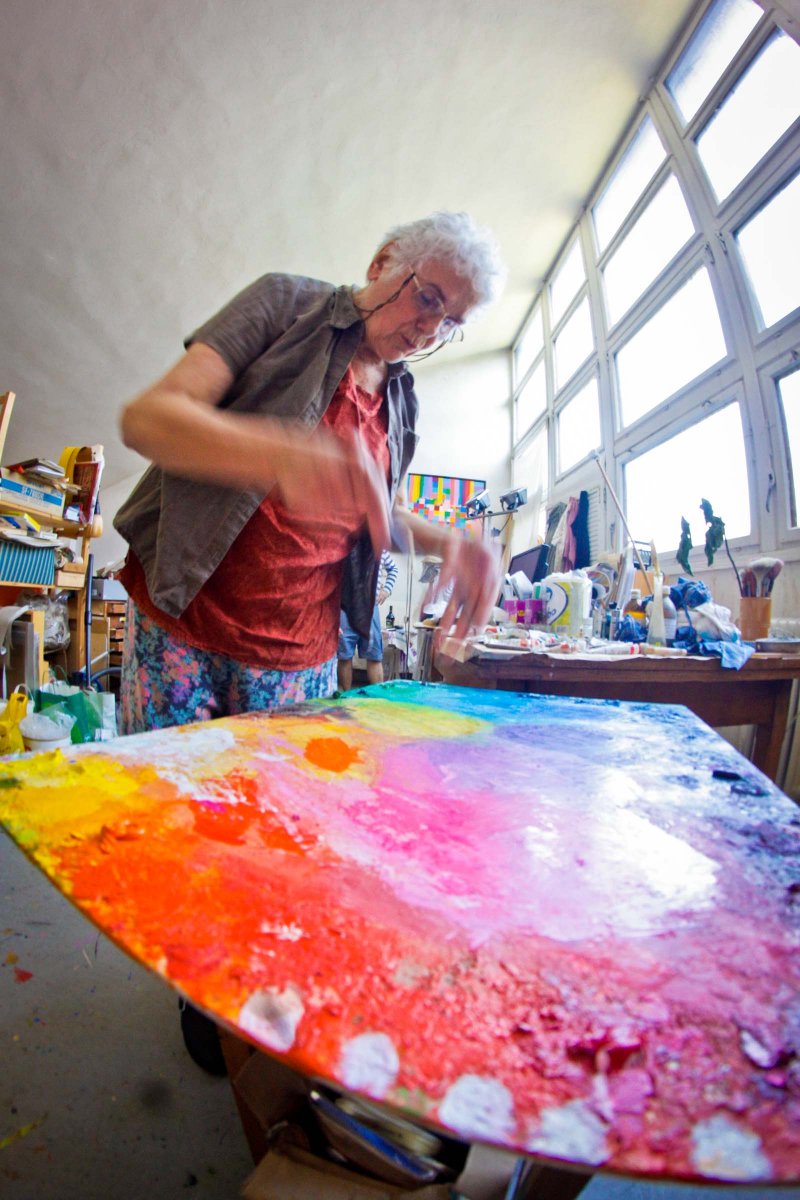
What is the ideal atelier like?
I like the one in Pécs, because it is above the city; however, the house being built on a slope is questionable. The chi rolls down the hill.
Sorry about grinning, but what would have become of your pictures if that chi would not have rolled down the hill. I liked going to your art studio, in clear weather the cat used to walk in…
The chi did not roll down for everyone (smiling). There was a gray cat. The Gray. Now that we spend less time there, the rolling cat-hordes have disappeared. I last saw the Gray last summer, later on, when we visited, we still saw some members of the gang. It is not a bad thing that some things come to pass.
We are talking in your atelier in Budapest, which is almost right on Ferenciek square.
When I look out the window, I can see the carved tower of the Franciscan temple. And a small spandrel. It reminds me of Rome. It feels like I am in Rome and not in Budapest. In 1950, I painted in the Török Pál street school behind Kálvin square. Back then, the Károlyi Castle served as the Modern Hungarian Art Gallery; it housed the 20th century Hungarian collection. In this neighborhood, something happened at every other house, I remember who came out the door thirty years ago, for example Dezső Korniss or someone else. This neighborhood feels like an extension of my apartment up until Belgrád rakpart. Meanwhile, I am longing for a garden. A house and a garden where it is quiet.
They asked Péter Nádas whether he writes down the ideas he gets at night. He said: no; if something is not important enough to remember until the morning, then it can be forgotten.
This is true, but it is not necessarily unimportant. In 1972, I stayed at an international art colony in Moravany, in Western Slovakia. For three months, we got everything we needed for our work in an old castle; they even cooked for us. There were German, Polish, Czech and Russian colleagues with whom we could talk about the profession. I used the opportunity to its fullest. Tamás Strausz, art-historian visited the place too from time to time and he told us a lot about West Germany. I could not finish one of my paintings, which I gave to him. My photo artist could not take a picture of it. As the years went by, I forgot about this picture; it appeared smaller and smaller… However, last year a picture resurfaced. Moreover, thanks to a high ranking gallery in Budapest. They knew nothing about its owner. At first, I only heard about it, and then I got to see it. I was awestruck at how important it was; bigger than I remembered. Its existence was only marked by a gray square in my catalogues. It ended up in a Swiss contemporary art gallery but first it was in my possession for two weeks. I made a blueprint-esque study about what order the textile embossed painting was created in. I did not realize back in 1972 that it was this good of a painting. Then it somehow made itself. It was there at my 2018 exhibition in London. The other story was unfolding parallel to this one. The tapestry laid there, neatly folded, airily packaged in a tall closet for years. No one cared about it. Then one time we unpacked it and those who were with me at the time were just staring amazed. But nowadays they are only looking for the early works. There are 30 new pieces just standing here. Nobody cares.
Later on, thirty years from now!
That is right! However, we do not have time for that. There are pictures that are hiding; there are ones that I know what collections they ended up in. One can do nothing but gaze.
Reality is like the sea.
How revolutionary were you in your youth?
I was never revolutionary, I am a good painter. And I am not avant-garde. Hungarian art-historians have been at each-other’s throats for decades; they must always categorize. And they carry the flag and their ideals together. I am not like this.
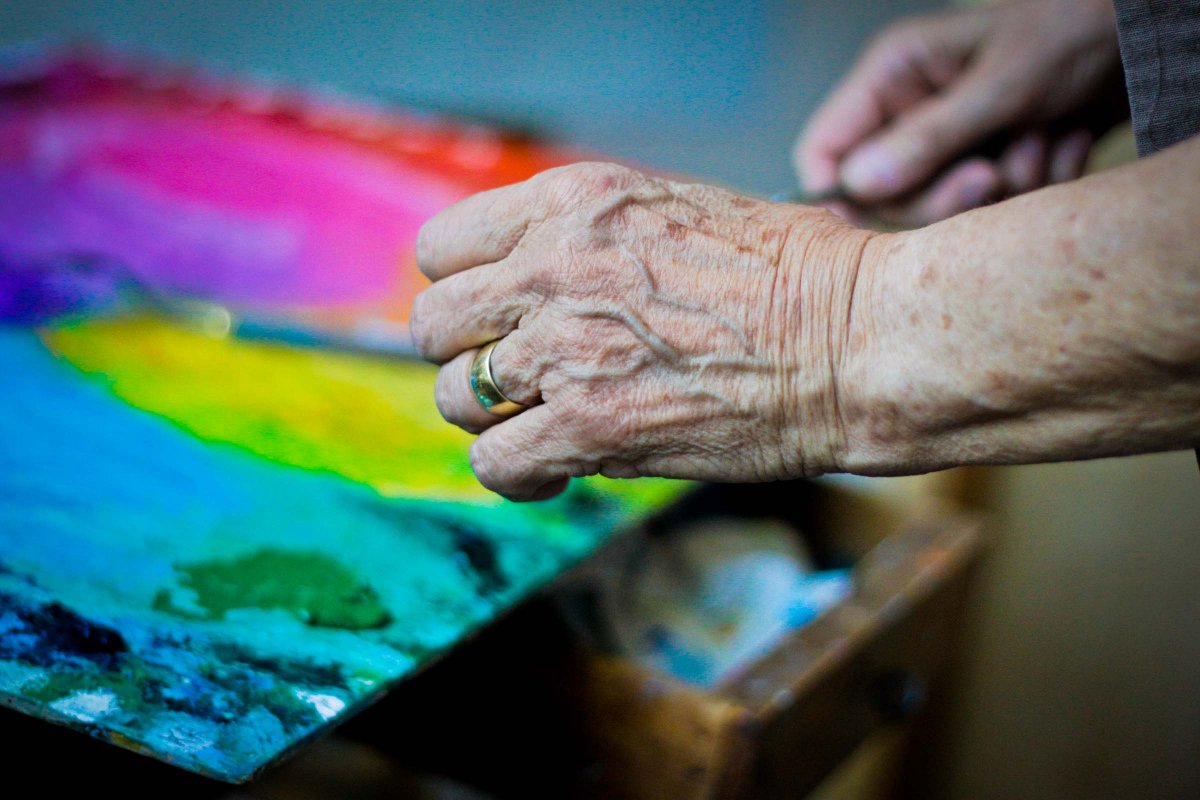
What are you like?
There is the craft and the profession to which defines a world in connection with it. In all sense of the word. It is important to start learning at the highest level before age 12. Everybody starts later. That however is different. I am very fortunate that Ferenc Martyn saw my childhood drawings. And I never could ask him what he saw. How did he see? For me there is nothing of importance in them. If I look at my older grandchild’s drawings, I can see a lot about his personality in them… Children are fantastic!
What did you get from Martyn when you were 12?
I received the highest level of acceptance and inclusion. I was put under such pressure that it was a miracle I did not collapse. He very consciously endowed upon me the knowledge that the expectations are impossible to meet. But it must be done. At age 14 or 15 most people tend to feel like the whole world is against them and they start to fight against both themselves and others. By then – during Mátyás Rákosi’s regime – I stood like an old sailor on the deck. I knew where I belong. Not to one group. I felt differentiated. With a greater power bestowed upon me a possibility and all the support I need, expecting a great deal of work from me.
Knowing that I am a painter. This has been highly significant.
I always kept a diary. I remember, when I wrote that I look upon the whole world as a painter. I was only 15 years old. I could even put it into words. I do not know how it sounds today. I worry that the world of art today is put in the shade. There are too many daily excitements.
What did your parents, your family think about painting?
My mother told me that the put the pencil in my hand when I was one year old. I drew every paper full. In Rábatamási, in 1945, after the Germans left the town, people charged the store and grabbed the canned foods and everything edible they could find. And I brought home multiple kilos of white cardboard and packaged pencils. This lasted for a long while. I used up any paper I could put my hands on. I have a diverse ancestry. I have many artisans among my ancestors. Big actors, several teachers, and one of my grandfathers even created instruments; he worked in the Angster factory. I drew a portrait of him when I was eleven or so years old. Mari Jászai was the sister of my grandfather. Fabled, great actress. How many squares are there the names of which have not changed in 50 years? The Jászai Mari square. We heard a lot of legends about Aunt Mari’s greatness. I had a lot of cousins with whom I spent the summers at the countryside. What a wonderful thing it was; mining clay on the bank of a fishpond for sculpting. The family standing around me. My aunts and cousins, while I just knelt there molding. This happened during the war. They wrote “Cinike, the little artist” on the photograph. This is how I was acknowledged. We organized plays – my childhood was like a dream; my godparents were officeholders at the Eszterházy-estate. My godmother was Joli Jászai (Keri) she organized plays with the servants, they enacted people’s plays; the people living nearby flocked to see them, and everyone in the castle loved them. We spent the summers there. No one bothered us; we formed a big gang with my cousins.
Where did the sculpting come from?
Nobody told me that I had to make sculptures out of clay. I remember that I found clay to be moldable. I dried and painted it… I was astonished when in 1963, I met an American woman in Rome with abilities akin to witchcraft who looked at my hand and told me that I was one day going to be working in the theatre. She prophesized this two years before I got my first commission from the National Theatre in Budapest.
At the age of sixteen, you already had an exhibition in Budapest.
In 1949, at the age of sixteen, I had an exhibition at the National Salon in Budapest as a member of the Pécs Free Lyceum. This was led by Martyn and two-three other painters at 2 Perczel Street. Martyn suggested this, when I was already going there regularly with my paintings and we talked for hours about them. He said that I should apply to the Free Lyceum. Anyone could go there. This marked the start of my serious studies. My parents knew I was in safe hands when I got to be at the exhibit in Budapest. They were looking for talented people. I could take a supplementary test. The entrance exam took place at Török Pál Street. One of my father’s friends lived at Reáltanoda Street. I stayed with them for three days of the entrance exam.
How does it feel like to be a woman above 80 who still wants something?
I got confronted with the thought multiple times, when I am dragging my cart, that here comes another homeless old crone and people are staring at me. Old people seem to be suspicious. Those who are old, are poor. Then they are going to steal or cheat. Or they want to get something they have no right to have. They want to manipulate or deceive others. I do not like going to restaurants alone anymore. Those who have gray hair are impure creatures. I believe I have the right to have white hair. To the grace of old age. Most of the elderly have tremendous knowledge even if they are unable to convey it straight up, even if they mix things up, even then. People are not “still alive” but “alive”. I do not have just a couple of days left, this is a period that people use and use up. Our relationship with time is very peculiar. I am not saying that I am going forward in it, but I am going somewhere.
Painting is a happy profession you do not have to marvel at someone who is a hundred years old and still painting.
Many can hardly stand old people. The fact that someone is old, a woman and still wants to do something irritates people. I sometimes laugh at this, but ultimately it gets to me. I try to make those who act this way towards me realize this. We are all equal before the law, but that is not the case. Besides being a sight for sore eyes as a woman, they would dare want to do something too? Now we have arrived at the point where we must address some rough topics. I am a human. People doubt this. Instinctively. They do not even think about it. I step through the door and their response is ready. I am cheerful now, but these are serious topics. In Hungary, I did not feel the need of expressing women’s rights activism. At 17 years old, I decided that my goal is to become a painter. And a good one. I wanted to be one of the greats. This shall reveal itself in fifty years if these components in which we created our career stick around.
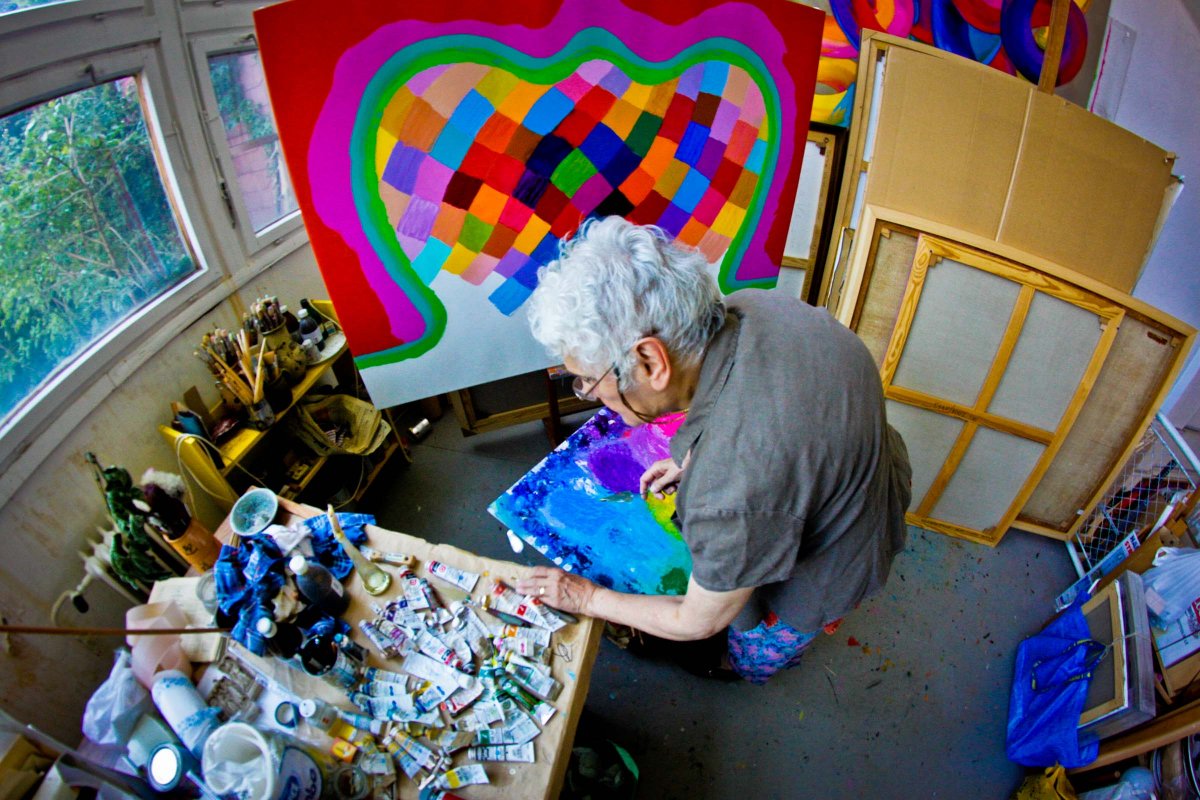
Can someone benefit from womanly beauty?
I look good on some pictures, but I have never considered myself pretty. I have documents about the times I dressed up as a boy in a masquerade. As a boy scout, or in art school as Don Juan, when I was wearing ski garments. In the reality of our existence there was no doubt that I was a woman.
Why did you not want to dress in women’s wear?
Maybe I wanted to be both. The beauty they saw in me was more of a human beauty. I was a slender, tall, skinny girl. In the fifties, large breasted American women were more popular in the movies than the Greek beauty standards. I ruled myself out of the race dominated by gigantic bosoms.
This reminds me of Anita Ekberg from Fellini’s movie, she was Swedish though.
Jayne Mansfield was a wonder breast like that. I browsed articles like this. How one can enlarge their breasts. It did not look very promising. So I stayed as I was. Looking back at some of my pictures, they say that I was beautiful. But why did they not say it then? I was struggling with an unmeasurable inferiority complex, even though I won the drawing competition in high school. This is what I comforted myself with.
While conducting a discussion I asked the audience to name a female painter besides Frida Kahlo. They knew one.
Who was it?
You.
What kind of audience was that?
University students.
Thank you!
by: Robert Balogh
photo: Szabolcs Csortos
- Log in to post comments
University of Pécs | Chancellery | IT Directorate | Portal group - 2020.







